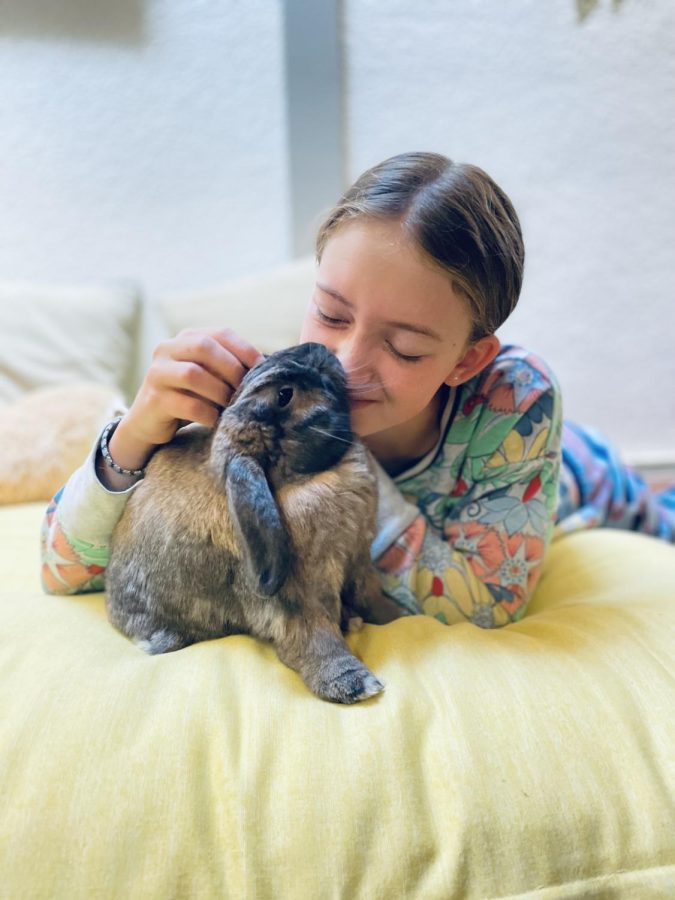My experience with animal-assisted therapy
How animal-assisted therapy transforms lives
March 1, 2023
I got my rabbit, Challa, certified as an animal-assisted therapy animal during the summer of 2021. I regularly take my rabbit to libraries and children read to him through the Reading Education Assisted Dogs (READ) program. Being a handler for my therapy animal has shown me how truly transformational the human and animal bond can be.
Oftentimes, there is some confusion between the terms therapy animals, service animals and emotional support animals. Assistance animals (service animals) are individually trained to do work or perform tasks for people with disabilities. An example of one is a guide dog for people who are blind. Emotional support animals (comfort animals) are pets that provide therapeutic support to a person with a mental illness. A person doesn’t need training for this, and instead go through a therapist or psychologist. Animal-assisted therapy (AAT) can provide physical, psychological and emotional benefits to the people they interact with, typically in facility settings such as healthcare, assisted living and schools. Many people are surprised at how many animals are eligible to become therapy animals. These animals include dogs, cats, rabbits, birds, guinea pigs, rats, miniature pigs, llamas, alpacas, horses, donkeys and mini-horses.
AAT provides numerous benefits, both emotional and physical. Let’s look into them a little deeper. For most people, the presence of an animal prompts the body to release serotonin, prolactin and oxytocin. These hormones generate a relaxation and stress-reducing response, according to UCLA Health. The hormone release can lower symptoms of depression, sadness and support positive mental health. Animals can also help children with neurological differences, such as autism, to perform better in their language and social therapies. People often tend to relate better to animals than humans in these settings. Easing communication and confidence, this helps with struggling readers and speakers. In 2013, a study looked at the impact of therapy animals on youth literacy rates. Students who worked with dogs demonstrated levels of improvements with net gains of more than a year’s growth in reading rate, accuracy, fluency and comprehension.
So what is the process to getting an animal certified? The first step is making sure the animal is up for the job. You want to make sure that working with patients, loud noises and being constantly pet, is something your animal not only will tolerate, but actually enjoy. Next is finding a program that will certify your animal. These days in age, there are a lot of programs that ask for money in exchange for a “certification” that are just words and actually fake. If there is a certain place you want to volunteer, for example a children’s hospital, I recommend calling them and asking what program they admit. The program I went through, which a lot of organizations require a certification with, is Pet Partners. Pet Partners is a nationwide organization that made the process and steps very achievable. The next step is getting registered and completing the online course. Most courses will ask you to pay a fee, however if this is an issue for you, there is most likely a grant or scholarship to help you out. My online course had a book and consisted of eight modules and a knowledge test paced by you. Once you pass the online exam with a score of at least 80%, it’s time for your in-person evaluation. Your online course will help you prepare for this and how to train your animal. Then, once completed, Pet Partners will help you find jobs or you can call different organizations to see if they’re interested. Then, it’s to the field you go. I also got a READ certification, which I use for libraries and schools, helping children with confidence in their reading.On a regular visit, I have children sit down next to me and exclaim, “I have never touched an animal before, this is the best thing that’s ever happened to me!” The pure joy radiating from faces young and old is so inspiring. Children come from other countries and are embarrassed to read in front of their American class. They will read to Challa softly, so I can’t hear, but they know Challa is listening, and feel safe. Being a handler for my therapy rabbit has been so moving and heartening, I’m so excited to see where the next visits will take me.




